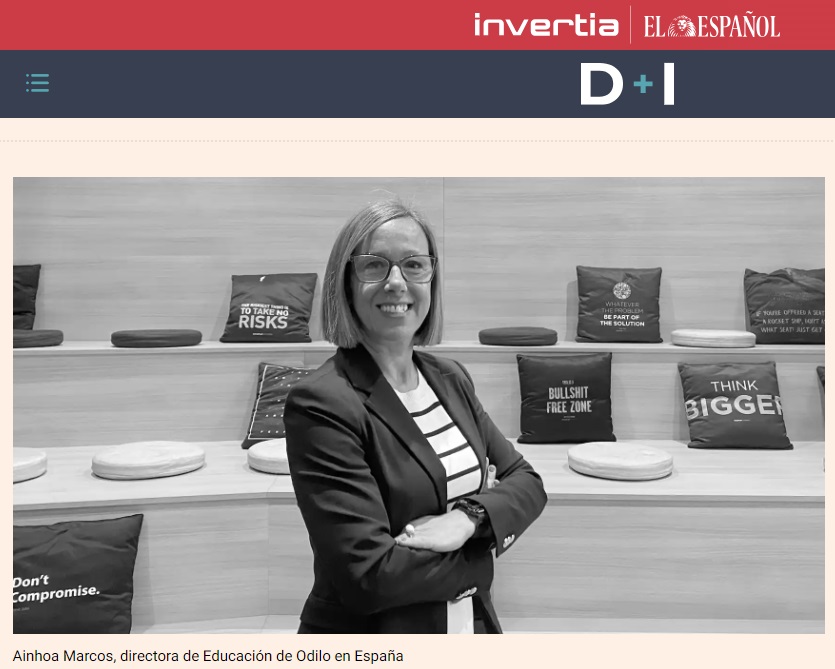Categories:
Published in the newspaper EL ESPAÑOL
By Ainhoa Marcos, Education Country Manager Spain at ODILO
Digitalization in education, especially through the use of screens in classrooms, has sparked a wide-ranging debate with numerous supporters and critics, particularly following the latest 2022 PISA results published by the OECD last December. As in almost any sector of society, this has led to an increasingly polarized debate, gradually moving away from what should be the key in this matter: adopting a balanced approach that maximizes the benefits of technological tools in the classroom, always understood as a means and not an end, and the proper training of all stakeholders, from parents and educators to, of course, students to make the most of these tools.
When exploring data, such as those presented in the PISA report, it is important to contextualize them. For example, this report reveals that 33% of Spanish students who use screens get distracted in class, especially in subjects like mathematics. A reading of the data, without context, could confirm biases about the drawbacks of digitizing classrooms; however, the reality is quite different.
Distraction is not directly caused by the use of screens, but by how they are employed. The OECD itself, in its reports, discusses both positive and negative impacts on students’ performance and well-being due to screen use, establishing a positive relationship between the intentional integration of technology in education and student performance. However, entertainment devices like smartphones can be distracting and have negative consequences. Therefore, it is crucial not to lose sight of the intentional nature of screen use in the classroom. In essence, the distracting nature of the device comes from its use for leisure during learning moments and not from the device itself—nothing new compared to historical distractions like playing paper games or passing notes in class.
This is why I believe the debate about screen use in education should shift towards a formative perspective on balanced screen use, recognizing them as tools for work and learning for everyone. Undoubtedly, education cannot distance itself from the technological world we live in; instead, it should offer opportunities to learn with and about technology.
The integration of technology in classrooms has been the subject of debate on numerous occasions. Let’s remember when, in 1986, some teachers protested against the use of calculators in math classes, and the press published statements against the employment of that technology. Nowadays, we observe a similar situation with the use of devices in the classroom or the use of artificial intelligence in education. Some parents, technology detractors, and educators express concerns about how digital devices affect education. Once again, we need to differentiate between the purpose of devices as tools for learning and the use of devices for learning versus students’ use of mobile phones for leisure.
However, it is essential to consider the numerous benefits that technology brings to the teaching-learning process before making hasty decisions because the digitization of education represents a new paradigm for which we must be well-prepared. There is no other way; therefore, we must choose to embrace it with all the guarantees that allow us to build a better world.
There are many positive impacts of technology in the classroom. Firstly, it enables instant access to a myriad of content and extensive educational resources. Students can explore concepts more interactively and participatively, promoting deeper and more meaningful learning. Digital tools also facilitate adapting content to different learning styles, giving each student the opportunity to understand and apply concepts effectively, allowing for personalized learning. Furthermore, it provides students with the best preparation for an already digitized and constantly evolving world. The current reality demands technological skills, and the use of screens in education gives students the chance to familiarize themselves with digital tools from an early age. This not only makes them more competent in the future job market but also fosters critical thinking and problem-solving in a technological context.
In the current digital era, where students consume content in their leisure time through various platforms, the question arises: why not translate this experience into the educational world instead of prohibiting it? Technology can offer a variety of high-quality educational resources that can enrich the learning experience. Educational podcasts, videos, interactive simulations, books, and audiobooks are just a few examples of how quality content consumption can be integrated into the educational environment. These multi-format resources not only serve as a complement to traditional teaching but also provide new perspectives and innovative approaches to address concepts, offering more meaningful, motivating, and closely aligned learning experiences with how our children and youth learn.
By promoting the consumption of quality content, media literacy is encouraged. Students develop skills to evaluate the authenticity of information, understand different points of view, and critically use various sources. These skills are essential in a world where information is omnipresent, and the ability to navigate through it informedly is crucial. However, these challenges must be addressed from a critical and proactive perspective. In conclusion, the integration of screens in education represents a significant advancement in the teaching-learning process, and we should not take it lightly. We must prepare students for a digital future, encourage proactive participation through these tools in the classroom, and design a more sustainable approach in the educational field. Teacher training is crucial in this regard. Teachers and parents should not be frightened by technology, nor should they prohibit it to avoid risks. Instead, we should promote its responsible use. The issue is not screens themselves, but the need for the system to actively involve us in their development. To achieve this, society must step forward and become aware of a change that we still have time to lead, as by prohibiting, we risk losing a valuable opportunity to prepare the new generations for the world that awaits them. Technology is not an enemy but a potential ally in the learning process.
